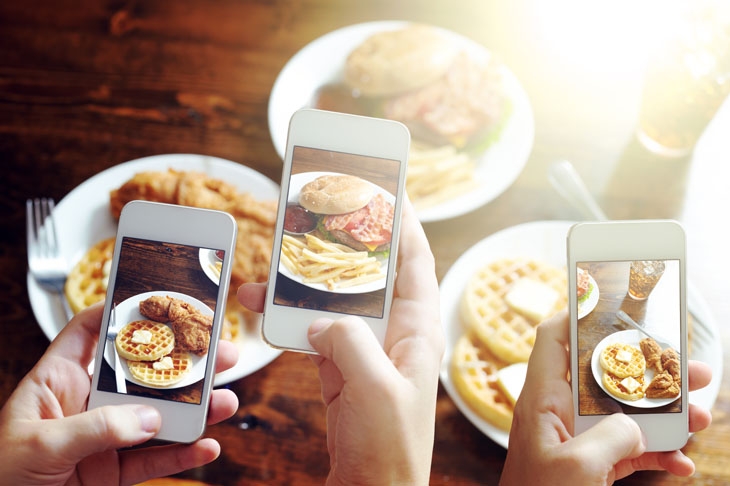On Sunday morning, in Puy-en-Velay, I climbed the 275 volcanic steps to the tiny chapel of Rocher Saint-Michel d’Aiguilhe. There, in the gloaming, among the silent stones that have stood on this site for 11 centuries, it was almost possible to imagine the awe of those very first Christian pilgrims who in the 10th century… CLICK! CLICK! CLICK!
Ah yes, the sacred selfie, now as much a part of the modern Camino de Santiago de Compostela as the rosary, the walking stick and the scallop shell. A Catholic grandmother taking photographs of her penitent grandson, devoutly picking his nose. A teenager snapping Insta-incense shots. A honeymooning couple in walking boots taking turns to light candles for the camera. A moment of quiet communion between pilgrim, God and several hundred social media followers. #holyhobnails.
No dogs, say the signs. No eating, no drinking, no littering. Could there be a sign that says no phones, no cameras, no flash, no duck-pouts in the cloisters, no gurning in the crypt? The old curatorial ‘look, but don’t touch’ should now be ‘look, but don’t click’. Then perhaps the pilgrim, whether she be religious or merely art historical, might get a little closer to divine revelation, not always seeing through an iGlass darkly.
Twitter, we read (if, that is, we read at all), has addled our brains. Gobbets, listicles, presidential perorations delivered in intemperate SHOUTY ALL CAPS. Read Proust? Read Tolstoy? Read this week’s New Yorker essay on the rise of the crypto-bitcoin bros? Not when attention spans are shot by hedgehog gifs and bunny memes. But what about Instagram? How many seconds does the average scroll-holer spend looking at each square-framed photograph? As long as it takes to read this sentence? This one? This?
I worry more about future art historians than future students of literature. Generation Y doesn’t use Twitter. Only 19 per cent of children aged 12-15 have Twitter profiles. That rises to 57 per cent for Instagram — an endless spool of filtered photographs — and 58 per cent for Snapchat, on which photographs and messages disappear after a few seconds. What does that do to a developing brain? How do you learn to really look at an altarpiece, a fresco, an Elizabethan miniature, if your attention span is somewhere between gnat and Kardashian?
How, for that matter, do you develop any sense of taste, judgment and connoisseurship if the only response available to you is a heart emoji? I can think of any number of responses to a Francis Bacon Pope or a Hieronymus Bosch goblin but an emoji just doesn’t cut it.
I salute Jennifer L. Roberts, professor of humanities at Harvard, who asks her history of art undergraduates to spend three hours in front of the painting they choose for their long essays. Students are ‘astonished’ by how much they eventually see. ‘If “patience” sounds too old-fashioned,’ writes Roberts, ‘let’s call it “time manage-ment” or “temporal intelligence” or “-massive temporal distortion engineering.”’
When it comes to patient looking, chance would be a fine thing. Visitor pressure means you are too often hustled from air-conditioned chamber to chapel to gift shop in the time it takes to say five Hail Marys. In Giotto’s Arena Chapel in Padua and in Mantegna’s Camera degli Sposi in Mantua, you look in a frenzy: tick-tock, tick-tock, sands running out, boot up the bum, that’s all folks.
No wonder people take photographs planning to play catch-up on the coach home. I wonder, though, how many tourists do look at photos later? And how much is lost to memory cards? There’s a misnomer: the card remembers, so you can forget. Have faith in your own eyes. Leave your phone in a locker and look as long as the guards will let you.
Everywhere we are geed up to take more and more photographs. Restaurants no longer light low to flatter date-night complexions, but floodlight for Instagram still lifes, or flat-lays as they are known. You, the customer, are saving the patron a fortune on advertising, marketing, and spreading the charred shakshuka word. Facebook trumps flavour. Ossobuco, shepherd’s pie, cassoulet are out. Unicorn noodles, edible nasturtiums and freakshakes are in. Call it clickbait cuisine.
A Museum of Pizza has opened in New York with displays that lend themselves to backdrops for taggable photos. Hotels now encourage you to steal their leopard-print and logoed dressing gowns. @dorchester @fourseasons @ritz. The decline of the Club 18-30 booze, boobs ’n’ beach break has been put down to millennials wanting more Insta–worthy holiday snaps. Not sangria sunburns, but Japanese tea bowls, Norwegian gables and Icelandic moss ganache. Generation Renters apparently maintain ’grammable nooks of their one-bed flats. A curated cactus-and-coffee-cup corner without an unlaundered sock in sight. They shelve their books by spine colour as it makes for the prettiest shelfies.
Against this endless onslaught, churches and galleries should be sanctuaries. Rare places to really look. A reliquary is not a lobster-burger and Caravaggio isn’t avocado on toast.







Comments